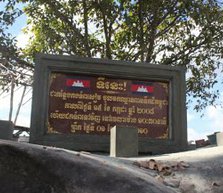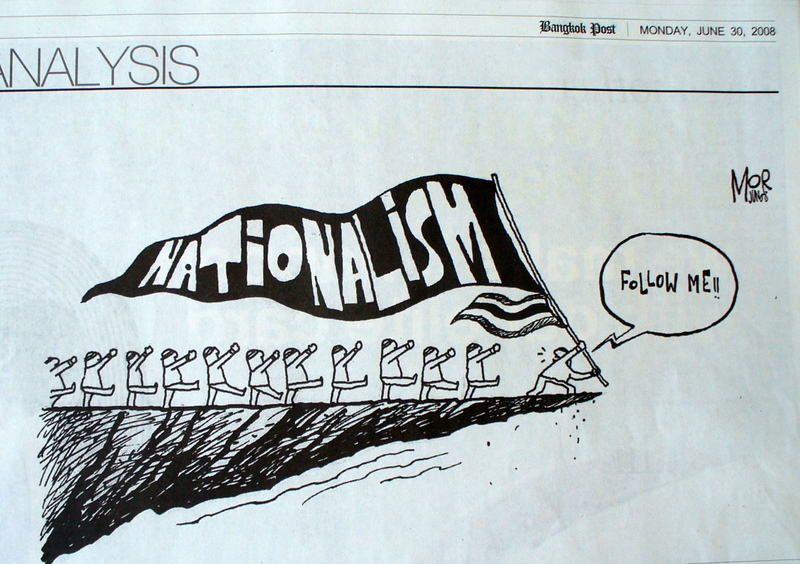The Mirror, Vol. 15, No. 703
Mail from the Documentation Center of Cambodia – “Independently Searching for the Truth since 1997” – carries the reminder:
“…a society cannot know itself if it does not have an accurate memory of its own history.”
It’s mail dated 9 February 2011 makes two important historical documents available: a copy of then Foreign Minister Prince Norodom Kantol’s letter to the UN Security Council of 23 April 1966 on Thai attacks and the capture of the Preah Vihear Temple, and the letter of Huot Sambath, then Permanent Representative of Cambodia at the UN, addressed to the UN Security Council on 17 May 1966 on the same issue.
The documents related to massive military actions of Thailand in contravention of the decision of the 1962 rulings by the International Court of Justice in The Hague, which had concluded in 1962:
For these reasons, by nine votes to three, finds that the Temple of Preah Vihear is situated in territory under the sovereignty of Cambodia.
This is an important part of the memory of the history behind the present conflicts at the Cambodian-Thai border.
That the memory – to be accurate – is much wider is obvious from the many different, additional views brought into the discussion. Some go back as far as the 11th century, when the Temple of Preah Vihear was built – not at all at a contested border area, but in a region which was at that time part of the Khmer Empire. Others refer to Thai-French negotiations and agreements from the years 1904 and 1907, when the independent Kingdom of Siam and the French colonial power over Indo-China were engaged to clarify border issues. But then – also part of the memory, after the end of the internal war with the remnants of the Khmer Rouge – there were several years of relative peace around the Temple of Preah Vihear, with a growing number of tourists, entering mainly from the side of Thailand into the area of the temple, where around one hundred Cambodian families earned a living from services and sales to tourists.
Events around and after the designation of the Temple of Preah Vihear as an UNESCO certified World Heritage Site in 2008 resulted in new conflicts and even the loss of human life, most of the time there was no ongoing armed conflict.
“Someone Explain Why” requests The Brunei Times in the Asia News Network,
This new round of gunfight will definitely not be the last armed encounter to take place in the disputed border zone, and the landmark temple will be a mute witness to many more needless bloodbaths and for what? Over a stretch of jungle? For national pride? Lives are being lost over murky reasons… National pride is indeed greatly valued in this region, but the two countries must remember that ruling and talking through the barrel of the gun is not the answer.
To explain why is extremely difficult given that information available is partly vague, and some information is contradicting to other parts of information. The latter is true not only for expected cases, where Cambodian and Thai sources may be oriented to their own conflicting interests. Such contradictions are much more surprising when they exist between statements of different sections of the media, or even different authorities in Cambodia.
The present conflict seems to have been started with the erection of a solid stone signboard near the Keo Sekha Kiri Svarak pagoda, saying:
Here! is the place where Thai troops invaded Cambodian territory on 15 July 2008
Thai authorities protested. On 25 January 2011, the Cambodian Minister of Defense communicated with Thai military commanders at the border, and he agreed to take down the tablet, “We agreed to move out the stone tablet sign. From now on, we do not permit to install any sign involving the countries’ relationship because it risks creating a problem.”
Fair enough – this place, several hundred meters away from Preah Vihear, is in the disputed territory of 4.6 sqkm around Preah Vihear.
But soon after the stone sign had been removed, another table was erected, creating more irritation:
Here! is Cambodia
Press reports are not clear who was responsible for declaring this part of the disputed are to be Cambodia.
After the Thai Army commander came with 20 armed soldiers to demand that the Cambodian troops remove the new tablet – “If you don’t remove such a negative tablet, I will erect a ‘Here! is Thailand’.” – The Cambodian sign was removed, in line with what the Cambodian Minister of Defense had agreed: not to “permit to install any sign involving the countries’ relationship.”
But then there was another sign, which more clearly than these tablets, state a position relating to the country’s national sovereignty, using the Cambodian flag on the pagoda – a symbol of national sovereignty in a contested territory. The risk to create a problem, which the Cambodian Minister of Defense had tried to avoid, had been made manifest.
What happened since is clear: people have been killed, maybe up to ten, and thousands have fled their homes not to get hurt or killed in further fighting.
What happened since is, however not clear: both sides accuse the other to have started shooting.
Cambodian government agencies had report that part of the Temple of Preah Vihear – a wing, or a wall – had collapsed as a result of shelling. By now, there is reporting in the media that no structural damage was visible, but just some shrapnel scars.
The Press and Quick Reaction Unit of the Office of the Council of Ministers had reported that the Thai army also used artillery gas shells. The use of gas in warfare has been prohibited by international law. My request for further clarification to this press office of the Government is without response since last Sunday.
One Cambodian soldier said that another soldier, who had been stationed at the temple’s stairs, had been killed by Thai shrapnel. But the spokesperson of the Cambodian Ministry of Foreign Affairs Koy Kuong said that “there has never been and never will be Cambodian soldiers at the Temple of Preah Vihear. This has always been a place for worship and tourism.” The Cambodian Daily, however, published on 9 February 2011 a picture of a Cambodian soldier at the temple. “The Foreign Ministry also denied yesterday that Cambodian troops had ever been at the temple, even as reporters were interviewing them there.” But the spokesperson of the Ministry of Foreign Affairs confirmed his previous statement, “I don’t know exactly, but as far as I know, no presence of soldiers at the temple.”
In the meantime, the Cambodian Prime Minister called for urgent intervention by the UN Security Council because of the “Thai invasion into Cambodia territory” – but the published wording was not clear whether this “invasion into Cambodia territory” related to Thai military presence in “contested Cambodian territory” – which is also “contested Thai territory” – or whether there was also Thai military presence in non-contested Cambodian territory.
A first round of tentative response from the UN administration – not yet from the Security Council – is a suggestion that ASEAN might be closer by and could initiate a process of defusing the tensions. Cambodia would accept this, while Thailand prefers mutual talks.
But this, too, seems to be difficult – until now, Cambodia has always upheld the principle that ASEAN should not get involved with internal affairs of a member country. At present there is again a conflict between countries which would like to see ASEAN to get involved more actively in Myanmar by sending an official envoy to this country, while Cambodia, Laos, and Vietnam had, in the past, always resisted such ASEAN involvement.
The Mirror has tried, over the years, to contribute to make resources available, so that “an accurate memory of Cambodia’s own history” is more easily and publicly available. That is why we carried the text of the Memorandum of Understanding between the Government of the Kingdom of Thailand
and the Government of the Kingdom of Cambodia on the Survey and Demarcation of Land Boundary, signed on 14 June 2000 – as far as we know, it has not been made widely accessible in Cambodia before. While it lays out a procedural framework, it does provide clues about how the two sides would address their common problems.
And while the accurate memory surely has to include documents from 1904, 1907, and 1962, the map and text of the Joint Communique of 18 June 2008, published repeatedly in The Mirror (but again, as far as we know, nowhere else in Cambodia) merit also consideration. These documents finally paved the way for the Temple of Preah Vihear to be made a World Heritage Site – with the words that “the Temple of Preah Vihear be nominated for inscription on the World Heritage List without at this stage a buffer zone on the northern and western areas of the Temple” – the areas where most of the military conflicts happened.
When the unsolved legal problems started to get emotional in 2008, the Bangkok Post carried a picture showing that Nationalism can lead to self-destruction. Maybe if this insight would get more attention and reflection, on both sides, new paths towards peace could become easier visible.
Norbert KLEIN
Have a look at the last editorial – you can access it directly from the main page of the Mirror.
And please recommend The Mirror also to your colleagues and friends.



Recent Comments